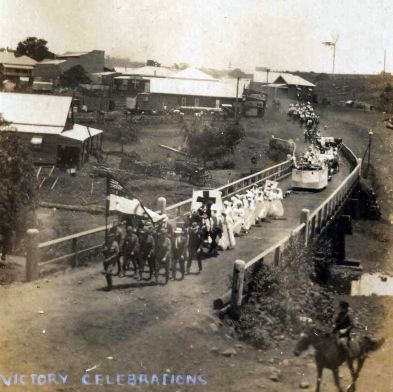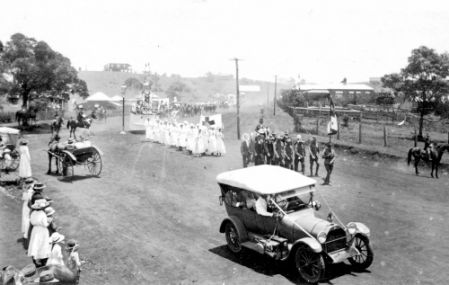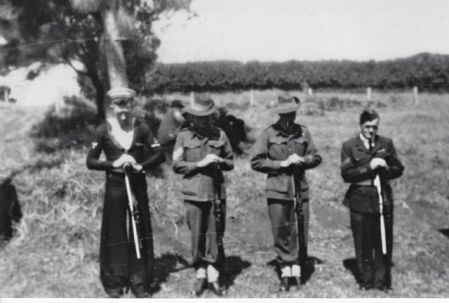Sub Branch History
The RSL in Maleny
No history of the RSL Maleny Sub-Branch Inc. would be complete without first giving a little history of the Returned and Services League of Australia Limited.
The RSL evolved as a direct result of the camaraderie, concerns and mateship shown by the “Diggers” for the welfare of their mates during and after the 1914-1918 War.

At a conference in June 1916, of the combined Returned Soldiers’ Association in Melbourne, the formation of The Returned Sailors and Soldiers Imperial League of Australia was born (RSSILA). The first congress was in September 1916, with delegates from Queensland, South Australia, Tasmania and Victoria. In 1940 the name changed to the Returned Sailors’ Soldiers’ and Airmen’s Imperial League of Australia (RSSAILA). The current title, The Returned and Services League of Australia Limited was introduced in 1990 (RSL). The League is commonly referred to as the “razzle”.

After World War 1, memorials were erected throughout Australia. These memorials took different images to represent the “DIGGER “who never died. The” deathless digger” was far from the only symbol. Death was represented by urns and broken columns, mourning by wreaths, remembrance by eternal light and torches, sacrifice by crosses, victory by laurel, triumphant arches and winged angel of victory, mankind by globes, honour by columns, fortitude by lions, regeneration by water and obelisks, and national birth by the rising sun.
The organisation built memorials, fostered ANZAC Day and nurtured the national identity was the Returned and Services Imperial League of Australia Limited.
Maleny’s memorial began with the Maleny Soldiers Memorial Hospital. During the WW1 discussions took place to erect a suitable memorial to the many boys who enlisted from the district. It was decided that the memorial should take the form of a Nursing Home. So the Soldiers Memorial Hospital was built on land purchased for a doctor’s residence.
Mr P Tesch erected the Hospital for 1157 pounds, with a further 300 pounds for furnishings. The money was raised by public subscription, with Dr Anderson as Medical Officer, with Matron Gorringe and a cook. The original hospital was where the Ambulance Station now stands. The current hospital land was secured by a State Government grant.
Want to know about Maleny Soldiers Memorial Hospital click here and here
In 1937, an interesting letter was received from the Brisbane & South Coast Hospital Board, addressed to the Secretary of the RSSAILA Maleny Sub Branch, with an account for treatment of three soldiers from Maleny. These soldiers were Messrs Clarke, White and Martine, the treatment cost 51pounds 3 shillings and 4 pence. The letter suggested that the if the account was not paid by 21 August 1937 that action would be taken under section 20 of the Hospital act of 1923 without further notice to recover the funds.
The Secretary forwarded the account to the Soldiers Memorial Hospital Board who responded as follows;
“Dear Sir; the committee of the Maleny Soldiers Memorial Hospital has directed me that the following resolution has been recorded in the books. We the members of the committee of the Maleny Soldiers Memorial Hospital at this our last meeting prior to the Hospital coming under the management of the Brisbane & South Coast Hospital Board hereby pledge ourselves to do all in our power to retain the Soldiers Memorial Hospital in Maleny and to see that Returned Soldiers receive free treatment.”
As a result of this letter and several from the RSSAILA the treatment account was withdrawn and the Maleny Soldiers Memorial Hospital still retains its name and the free treatment of returned service personnel.
A Sub-branch of the RSSAILA in Maleny came into existence on 8 May 1931. On this day, thirteen foundation members assembled although all their names are not recorded. The president was Rev.H K Cornish, (Church of England Minister of Maleny), who was the president from 1930 to 1932, and married Eunice Harland a schoolteacher from Bundaberg.
The Vice presidents were G Newton, R Cox, C Winning, and the Secretary HE Thomas while the Treasurer was Mr R Lindsay. They agreed to meet regularly on the Friday on or before the full moon, so members would be able to find their way home easily. At the conclusion of the meeting all sat down to a large festive board laden with pig’s ears and other sundries.
At the end of the WW2 the membership had risen to 69 members, while today over 240 members (some service members but many more social members) are on the roll. The first recorded minutes of the Maleny Sub-Branch available, took place on September 14th 1940. The meeting assembled in the School of Arts.

L to R – Alex Dickson (Sailor) WW11, Leo Clancy (Army) WW1,
Jim Smith (Army) WW1, Alf Wilcocks (RAAF) WW11
This is not the first record of the Maleny Sub Branch, this occurs on the 28th August 1932 with the following financial members present, in the members register. Messrs R J Lindsay, RVD Cox, JC Lemass, W Smith, H Warne, WH Jones, W Walters, F Rowell, G Newton, HE Thomas, C Winning and WH Rough.
The President, Rev.Cornish’s apology was accepted. The Clubroom was in the School of Arts. (Now the Maleny Community centre).
In 2001 the RSL Maleny Sub-Branch celebrated its 70th birthday in May with a Mature Age Debutante Ball. The State president Mr Ray DeVere MC officiated.
The Sub Branch has seen a female President, Mrs Helen Gilmour-Walsh, making her mark on this previously male dominated bastion. It is always pleasing to see the changes made by presidents to the facilities and to the Sub Branch’s social standing within the community.
In 2002 the Sub Branch received a grant from the Queensland Gaming and Community Benefit Fund; it was used to further renovate the toilets in the hall. To complete the toilets the existing stage had to be removed and the timber from the floor was reused to enhance the walls of the new construction. While the renovations were in progress, it was decided to improve the bar facilities of the RSL Hall at the same time.
See Hall History for more information on the fascinating history of the RSL Hall.
The future of the RSL Sub-Branch is in the hands of its members. It is pleasing to see the changes that are being made to the hall, to enable it to provide comradeship and facilities that will allow it to keep pace with the ever-changing face of this country town.
Thanks to Frank Beattie for this history
